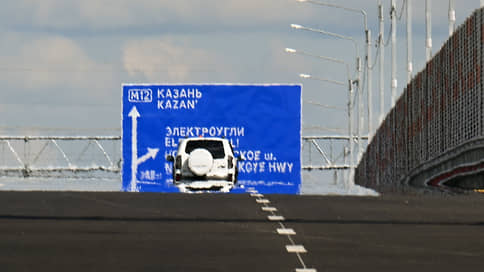Rostransnadzor issued more than 1 million fines for non-payment of travel on toll highways in 2023
[ad_1]

Rostransnadzor issued more than 1 million fines for non-payment of travel on toll highways in 2023, Kommersant found out. Most of the resolutions were received by users of the Central Ring Road (TsKAD) and M-12 Vostok. At the same time, 34% of fines were canceled because car owners managed to pay off the debt. The lion’s share of drivers are punished due to their own inattention, experts say; citizens are not yet accustomed to the “Free Flow” system, when you can enter a toll highway without a barrier. Trying to avoid paying a toll, a number of drivers drive with mud-stained license plates; software with neural network elements is used to recognize such vehicles.
Rostransnadzor and the state company Avtodor, at the request of Kommersant, disclosed statistics about drivers who did not pay for travel on toll roads. This violation is recorded mainly on routes with the “Free Flow” system, where barrier-free travel is in effect, and funds are debited from the user’s account (for example, the Central Ring Road and M-12). The law gives the driver five days to pay the debt, and, according to Avtodor statistics, 95% of drivers meet this deadline. If the debt is not paid, then the materials are transferred to Rostransnadzor for imposing a fine under Art. 12.21.4 Code of Administrative Offenses (1.5–5 thousand rubles depending on the type of vehicle). After notification, the driver is given another 20 days, and if he pays the toll debt, the fine will be canceled.
As it turned out, from January 1 to November 27, 2023, Rostransnadzor issued a total of 1.05 million fines under Art. 12.21.4 Code of Administrative Offences. The vast majority – 963.5 thousand – were due to unpaid travel on the Central Ring Road and M-12. But 327.6 thousand of them were canceled because citizens repaid the resulting debt within 20 days. As a result, Rostransnadzor sent only 20% of the fines from the Central Ring Road and M-12 to the Federal Bailiff Service for enforcement.
The capital’s roads with the Free Flow system accounted for 87 thousand fines. Thus, on the Moscow High-Speed Diameter (the fare costs 950 rubles for transit users, residents of the capital and the Moscow region do not pay) 77.2 thousand decisions were issued. Subsequently, 28.4 thousand were canceled due to payment. For driving on Bagration Avenue (costs 600 rubles for all drivers), 10.3 thousand decisions were issued, 501 were cancelled.
From motorists who have not paid the toll after 20 days, Avtodor collects the debt within the framework of the Civil Code. In 2023, the state company sent more than 334 thousand pre-trial claims, of which 252 thousand were voluntarily paid. When the driver does not respond, the state company goes to court – in 2023, 45 thousand claims were sent; to date, the state company says, 15 thousand of them have already been satisfied. However, more than 4 thousand court decisions had to be sent to bailiffs for forced collection. “The state-owned company is making every effort to ensure that debtors pay off their debts voluntarily, without involving the FSSP,” Avtodor said. “Of course, all court decisions will be executed. At the moment, the state-owned company is also actively interacting with banking institutions to collect debts.”
Some drivers hide license plates from cameras in order to avoid paying tolls, but the problem, judging by Avtodor data, is not widespread: such motorists account for no more than 1% on the Central Ring Road and no more than 0.5% on the M-12. Let us remind you that according to Art. 12.2 of the Code of Administrative Offenses, for an unreadable license plate (for example, stained with mud), a fine of 500 rubles is applied. If it is removed or hidden, the driver faces deprivation of his license for up to three months or a fine of 5 thousand rubles. “In order to reduce violations, traffic police raids are regularly carried out,” said Avtodor. “If it is discovered that a person is driving with unreadable signs, the operator carries out a set of measures to identify the vehicle. In most cases, the vehicle is identified and the debt is billed to the owner.” “We use domestic software to recognize dirty license plates,” Marcel Nigmetzyanov, general director of United Operator LLC (operates the Central Ring Road and M-12), told Kommersant. “A neural network based on machine vision analyzes each license plate and tries to further recognize what was not recognized at the moment of passing under the frames, which significantly reduces the percentage of unrecognized vehicles.”
Most of the fined drivers most likely simply did not understand that they had driven onto a toll road, said Petr Shkumatov, coordinator of the Blue Buckets movement. Firstly, he explains, navigators often automatically lead to paid areas, and notifications, as a rule, are not informative enough. The expert suggests artificially slowing down the speed at exits to the Central Ring Road-M12 and installing large information boards there that say “This is a toll road.” “Due to their inattention, drivers do not immediately understand that they are driving on a toll road. Moreover, there are no barriers,” agrees Igor Morzharetto, a member of the public council under the Ministry of Internal Affairs. A Kommersant source familiar with the situation adds that the number of defaulters may increase due to the influx of drivers from regions where they are not yet accustomed to toll roads on the M-12 and the Central Ring Road.
At the end of December, we recall that Avtodor plans to open several sections of the M-12 between Arzamas and Kazan, where the Free Flow system will operate. And from September 1, 2024, a law will come into force according to which fines for driving on regional toll roads will be set by local authorities, and Art. 12.21.4 of the Code of Administrative Offenses will be applied only on federal highways.
[ad_2]
Source link








